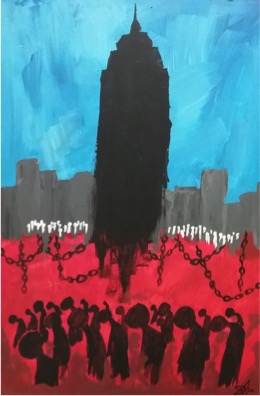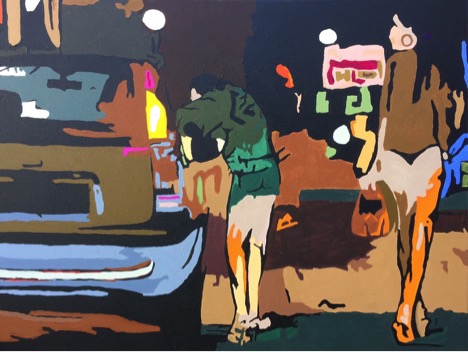August, 2017 Monthly Reflection
August 3, 2017Traffik 2017: A New Art Exhibit about Human Trafficking
Marlene Weisenbeck, FSPA
On May 11-12, 2017 Mayo Clinic-Franciscan Healthcare in La Crosse, WI held its 20th annual conference on Child Maltreatment with support from the Gundersen National Child Protection Training Center, Coulee Region Child Abuse Prevention Task Force, Family & Children’s Center – Stepping Stones, the La Crosse Task Force to End Modern Slavery, and Viterbo University Art Department. This nationally recognized conference addresses strategies that multidisciplinary teams can use to intervene when child maltreatment is reported, collaborate with community and family to protect children, and ensure justice for child victims of abuse/neglect.
This year the conference devoted a full day to human trafficking. Speakers addressed national and state legislation, human trafficking in a globalized context, assisting victims, and suppression of demand on the part of law enforcement. A special feature of the conference was a nationally juried art exhibit organized and presented by the Viterbo University Art Department, entitled Traffik 2017. The goal was to create a space for artists to express themselves, and for others to dwell among works that have been highly considered, in the context of this issue. The call to artists invited submission of works with an implication for introspection on the theme, the issues that surround it or its effects, and to explore broader interpretations of issues that it raises, such as oppression, illicit economies, invisibility, innocence, social justice and others. (http://www.viterbo.edu/art-department/traffik-2017-call-artists)

Image by Margaret Miller, Viterbo Art Alumni 2014
Viterbo University received some 50 entries from artists all over the United States and one from Austria. Since the call was open to anyone 18 years of age and older, entries represented the full spectrum of working artists, from high school and college students, to university professors, to professional and amateur working artists. The jury selected 28 pieces for the show.
A sampling from the exhibit is shown here with the permission of the artists. Their own words describe their creations.
 Barbed Wire with Butterfly #2
Barbed Wire with Butterfly #2
By Daniel Stokes
Terra Cotta
I have chosen to describe the theme by illustrating the contrast embodied by my subject matter, butterflies and barbed wire. The butterfly representing the fragile, the harmless, the beautiful. All those precious things of this world that are vulnerable by their very nature including men, women, and children.
Barbed wire, whose sole purpose for existence is to inflict pain, as a symbol of the methods and attitudes of those who in service of greed would control, imprison, even enslave the weak and innocent through threats of violence, to whom human beings are nothing more than mere property to be bought, sold, and ultimately destroyed.
 Dark Cities
Dark Cities
by Anna Lucille Strunk (Lucy)
Acrylic
The top half of the painting shows Americans going about their everyday lives. The blue background reflects a calm and cool world, where there is nothing to be concerned about. The white figures are the everyday people, going about their lives in the cities and towns. The small size and white color represents how most people don’t think outside of their little worlds, and how they believe everything is right and pure.
The lower portion portrays the suffering of people and children taken by the calamity of human trafficking. The red background represents the burning pain and suffering experienced by these individuals. The hunched, black figures are those who have been taken and sold into slavery. They are a larger size than the white figures above because the problem of human trafficking is larger than we think it is. The bent over posture is for the treacherous work they are put through, and how they are sold to people who make things that we use every day, being put in a position that, in an unfortunate way, supports our country.
The black city and Empire State Building that rests over the bottom half of the painting represent the United States being ignorant or ignoring the issue. Our “perfect” little world has horrible and tragic happenings occurring beneath it.
 Selling
Selling
Rick Carraway
Acrylic on canvas
In painting Selling, I wanted to capture the commerce of selling oneself to survive, and probably not by choice. The Swedish government has found that much of the vast profit generated by the global prostitution industry goes into the pockets of human traffickers. The Swedish government said, “International trafficking in human beings could not flourish but for the existence of local prostitution markets where men are willing and able to buy and sell women and children for sexual exploitation.”

This image was not submitted to the exhibit, but represents in a survivor’s own efforts how art can be helpful in the struggle toward healing and freedom.
Survivor Woman
By KN (survivor)
Acrylic mixed with other mediums
Most of the symbolism is in the side where the face is dark or shaded. It represents either the side of us we don’t know or the side we want to be unknown. The side that makes it look as if the wind is blowing to me represents how we are constantly changing. I also think the earthy colors are grounding.
“KN” affirms that art is another way to convey the message from the survivor. Art therapy opens up areas that have been blocked and helps the individual get at the pain from another angle. It functions like a castle with different doors where one can enter the memories and work with them. The doors can be closed again and issues can be put away when the survivor is not working on them. For her, the castle concept is a way to contain the reality so that it cannot have a continuously destructive influence on her life.
Art is frequently used in healing modalities for survivors of human trafficking. It also provides an entry for understanding more clearly the reality of this criminal activity which engulfs our world. Viewers at the Traffik 2017 art exhibit found it profoundly meaningful.
The obvious benefit of the Mayo Clinic-Franciscan Healthcare Child Maltreatment Conference was not only the knowledge conveyed in a variety of ways, but the collaboration among social institutions that is essential to making a contribution to ending modern slavery in the 21st century. Mayo Clinic-Franciscan Healthcare and Viterbo University are sponsored ministries of the Franciscan Sisters of Perpetual Adoration in La Crosse. The author of this article convened and continues to chair the La Crosse Task Force to End Modern Slavery.
Traffik 2017 will be on display at the Viterbo University Art Gallery from August 30-September 29, 2017. For more information, Department Chairwoman Sherri Lisota, can be contacted at sjlisota@viterbo.edu.
Tags: Coulee Region Child Abuse Prevention Task Force, Family & Children’s Center, Gundersen National Child Protection Training Center, La Crosse, La Crosse Task Force to End Modern Slavery, Mayo Clinic-Franciscan Healthcare, Viterbo University Art Department
Category: Arts and Creative Activism, Monthly Reflections, The Alliance to End Human Trafficking

